Abigail the 4-year-old guinea pig
Guinea pigs are in the rodent family (related to chinchillas and porcupines). Half of the mammals in the world are rodents. The order is so huge that it had to be divided into suborders: Sciuromorpha—squirrel-like rodents, Myomorpha—mouse-like rodents and Caviomorpha—cavy-like rodents. Guinea pigs are cavy-type rodents. They are warm-blooded mammals. Like most cavies, the guinea pig has short legs, a short neck, a big head and no tail. There are different types of guinea pigs the American, Abyssinian, Himalayan, Peruvian, Rex, Silkie, Teddy, Texel, White Crested and even two hairless types called the Skinny Pig and the Baldwin Guinea Pig.
Entertaining and gentle, the pet guinea pig is vocal and delightful. They have become very popular pets because of their docile temperaments, tendency not to bite or scratch when handled, relatively clean habits and availability. They are sociable animals and enjoy daily interaction. When their person walks into the room they let out a "bweeep - uueeeep" as if to say, "Hello, got any tasty treats for me today?" A guinea pig tends to run when you try to pick it up, however a guinea pig that has been handled since it was weaned will be well-mannered and gentle once you catch it. Guinea pigs are social animals, like horses and wolves, and are best kept in herds of at least two. On very rare occasions, a guinea pig will not accept another guinea pig. Males must be kept with males and away from females, as the smells will drive them to fight. Females must be kept with females. If you have a neutered boar, you may have him with any number of females (but no males). Unlike most rodents, guinea pigs are some of the few animals where gender does NOT matter in compatibility—for both males and females fighting is entirely dependent on personality and space. It is best if they're gotten from the same litter, but bonding two guinea pigs from different litters is not as hard as one might think. Try as hard as you can before keeping a solitary guinea pig. Please have an exotic veterinarian sex both of your guinea pigs before you put them together, to keep breeding from occurring.
Length: About 10 - 12 inches (25 - 30 cm)
Height: About 5 inches (13 cm)
Weight: About 2 pounds (.9 kg)
Guinea pigs can be housed within enclosures made of wire, stainless steel, durable plastic or glass. Keep in mind the following with each: if using a cage with open wire sides, you should look for a cage with a solid bottom with sides that come up at least three inches as the pig will knock pieces of bedding out of the cage (see photo below). Plastic or glass aquarium cages are not recommended because they are less ventilated and breathing in the fumes from the urine is very bad for the pig. Wire enclosures are prone to corrosion. Wood and similar materials should not be used in the construction of their cage because they are difficult to clean and cannot withstand gnawing. Wood hide-away-huts are OK, as long as you know they will gnaw on them. These huts should be thrown away every month and replaced with a new one should urine start to build up along the edges. Guinea housing should have about 7.5 square feet for one guinea pig, adding 2-4 feet per companion (please note that boars may need additional room to avoid territorial issues). An open-topped enclosure can be used as long as the sides are at least 10 inches high. Solid floor enclosures with easy-to-clean, dust-free beddings are best for guinea pigs. Your guinea pigs’ home should be easy to clean, well-lighted and ventilated. Shredded paper can quickly become soiled beyond use, as it does not absorb well. Wood chips are fine. Corn cob does not absorb well, molds quickly and expands when wet. Guinea pigs will often eat a nibble, which will expand in their stomach. If they eat too much, they can quickly become fatally impacted. Sawdust should be avoided since it does collect within the external genitalia of males, and it's often VERY dusty and doesn't absorb well. Avoid both cedar and pine shavings, as they both give off phenols which are toxic to the delicate respiratory systems of guinea pigs. (Kiln dried pine does not have this problem and is okay to use.) Acceptable beddings: Aspen, fleece, paper-based beddings such as Carefresh.
Cages should be cleaned out at least every other day even if you use the wire mesh drop-through bottom. A wire mesh drop-through bottom is not recommended, as the bottoms of the pigs’ feet can become injured. Their feet can get what's called 'bumble foot' (very painful, often infected open sores that form on the bottoms of the feet), as well as broken legs and feet. Their nails will often get caught in the mesh, and pulled off. This is painful and takes a long time to heal. Urine must be cleaned from the bottom of the cage every week using a disinfectant for animals and vinegar to scrub away crystalline deposits of urine.
Nails should be clipped on a regular basis. Toenails that are not clipped will start to curl back around and grow into the pig’s foot. Short and medium-haired guinea pigs require less grooming, but some very longhaired guinea pigs need their coats brushed so they do not get tangled. The coat of the longhair may be very long, draping all around, covering the feet and trailing behind it as much as 6 inches. This type of coat requires regular, careful grooming. Longhaired guinea pigs are often the types shown in guinea pig shows. Show pigs with hair long enough to sweep the floor are kept in rollers to reduce tangling and matting with dirt or feces. Longhaired guinea pigs are not found in the wild but are a mutation that was bred into captive guinea pigs. The hair on longhaired guinea pigs never stops growing, much in the same way as humans and horse tails. Most other mammal hair reaches a certain length and then stops until the root either falls out or is pulled from the follicle. Guinea pigs do not require regular baths but may need one if they are dirty or have had diarrhea. To bathe a guinea pig, place a towel down in a clean sink and put an inch or two of warm water over the towel. Do not fill the sink too full. Place the pig in the sink and use a dime-size amount of soap made for guinea pigs, rabbits, puppies or kittens. Do not use human shampoo. Be sure to rinse all of the soap off of them by using a cup. Pour fresh warm water slowly over the pig. Drain the soapy water from the sink and add more fresh warm water. Rinse the pig one more time to ensure all of the soap is rinsed off. Do not let the pig get cold. After the bath, wrap them in a clean dry towel and do not put them back in their cage until they are dry. Show guinea pigs are usually not bathed at all if it can be helped because bathing removes the oils in the coat. Guinea pigs like to groom themselves and those around them. If a guinea pig is sitting on your lap they may start to groom the human. Stroking the pig or one-finger scratching behind the ear will often elicit grooming. Be careful when a guinea pig starts to groom your skin as even a scrape from their sharp rodent teeth can result in a pinch that can hurt. Longhaired pigs that aren't showing are often trimmed to aide in keeping poo and such from gathering in their fur.
All cavies are herbivores (vegetarians). They eat a variety of fruits and vegetables along with green pellets with vitamin C, plus green grasses. Gnawing on grasses and hay keeps their teeth filed down. Guinea pigs that are not nursing, pregnant, or under 7 months of age should not eat alfalfa, as it is too high in calcium and causes stones. It is only acceptable as a very occasional treat. Alfalfa pellets should only be fed to guinea pigs under 7 months of age, and a timothy-hay based pellet to 7+ months of age pigs. They need about 30 mg of vitamin C per day. Like humans, guinea pigs do not make their own vitamin C, so they must always eat foods high in vitamin C and should have some kind of vitamin supplement which you can pick up at just about any pet store. Note that rabbit pellets and guinea pig pellets are different. Guinea pig pellets have added vitamin C in them whereas rabbit pellets do not; however, keep in mind, pellets older than 6 weeks lose over half of their added vitamin C. Guinea pigs take in small amounts of food all day long. You can feed your guinea pig pellets and fresh fruit and veggies twice a day and leave hay for him to munch on when you are away. Keep watch that your pig is not putting on too much weight. Any fresh food fed should be thoroughly washed before feeding. Water should be available and fed in a gravity driven hanging bottle at all times. These bottles can be found in your local pet store. Guinea pigs like to gnaw on things. They have front teeth that never stop growing so it is important to provide things for the guinea pig to gnaw on to keep these teeth filed down. If the teeth grow too long they will not be able to eat. If your guinea pig’s teeth appear to be getting too long take it to the vet; the vet can file the teeth down to normal size.
Guinea pigs will enjoy being taken out of their cage for some freedom. Since they are bigger and slower than hamsters they are easier to monitor. A guinea-proof enclosure should be set up. Be sure there is nothing you do not wish for them to chew in reach such as wires or potted plants and that there are no other pets around that can harm them.
About 6-9 years, some have been known to live up to 10 years. The oldest guinea pig on record is a pig named Snowball who died at age 14.
Prone to intestinal infections, heat stress/heatstroke, foot conditions, pneumonia, malocclusion of premolar teeth cancer and scurvy/vitamin C deficiency. Vitamin C deficiency is common among domestic guinea pigs. Too little vitamin C can kill a guinea pig and too much can also do the same. There are vitamin C supplements you can give your pig. Consult your vet about giving him supplements, what type to feed and how much to give. Guineas are also prone to some skin problems such as fungal growth and mites. If your guinea pig appears to be scratching and/or losing its coat, consult your vet.
Guinea pigs are bred in the summer months. Gestation is nine weeks, a long time compared to other rodents. Unlike mice and rabbits, guinea pigs are born with fur and their eyes open. They look like miniature versions of their parents when they are born. They nurse right away and will even start eating solid food 2 or 3 days after they are born, however they will nurse for 2-3 weeks. They usually have litters of 1-4 young. Sexual maturity is reached at about 60-70 days. They will continue to grow for several more months. Males left with the females in captivity will try to drive young guineas away soon after weaning.
In America, guinea pigs are also called cavies. Guinea pigs came from South America, where they were domesticated by the Incas in 2000 B.C. and appeared in Europe in the 1500s. The Incas used to farm them for food as a source of protein. In fact, even today you can still order a fried guinea pig in South America. Wild guinea pigs still live in parts of South America; they inhabit grassland and rocky regions from Peru to north Argentina. Wild guinea pigs live in family groups and occupy underground burrows deserted by other animals. They are active at dawn and dusk and feed on grass and leaves. They live in groups of 5-10. A young guinea pig can run when it is only three hours old! Some species of wild cavy can be as long as a meter. Some say they are called guinea pigs because they were brought to Europe by Spanish sailors from a country called Dutch Guiana in South America; others say it was because in England they were sold for a guinea, which is a coin. Guinea pigs are often used for medical research. That's where we get the term "guinea pig" to describe somebody who volunteers to go first.
My little Abyssinian guinea pig, Maximus at three months old.
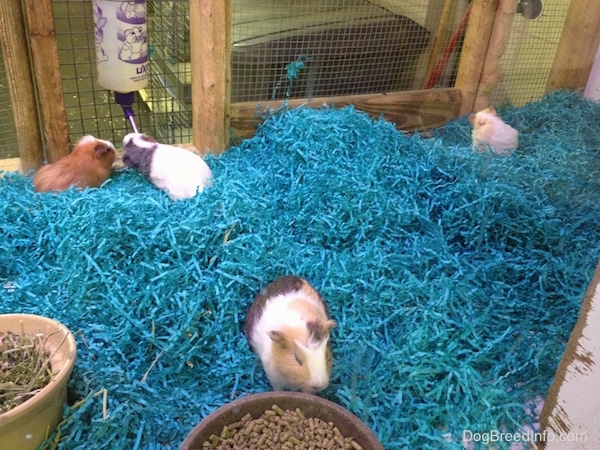
Guinea pigs all living happily together in a large cage.
A guinea pig's nails should be clipped on a regular basis. Toenails that are not clipped will start to curl back around and grow into the pig’s foot. (Ouch!)
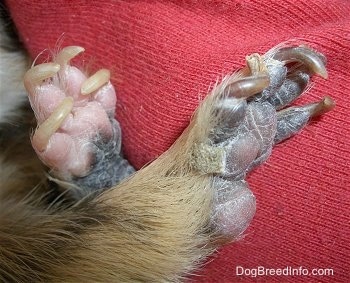
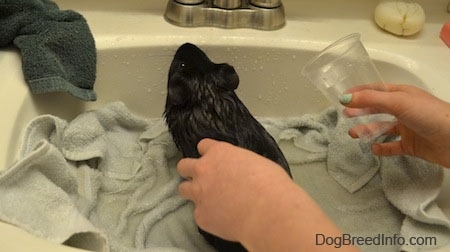
Guinea pigs do not necessarily need a regular bath, but if you own one you may find that there will be times when they do need one. To give a guinea pig a bath, place a towel down inside a clean sink. Put an inch or two of warm water in the sink. Be careful not to make the water too deep. Put a dime-size amount of guinea pig, rabbit, kitten or puppy shampoo in the palm of your hand and lather it up. Do not use human soap. Be careful not to get the soap in its eyes.

Use a cup to rinse the pig. Drain the soapy water, refill the sink with clean, warm water and rinse the pig again to ensure all of the soap is washed out.
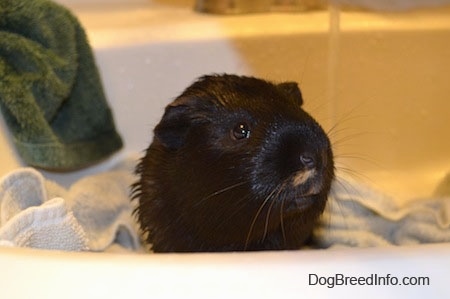
Do not let the guinea pig get cold.
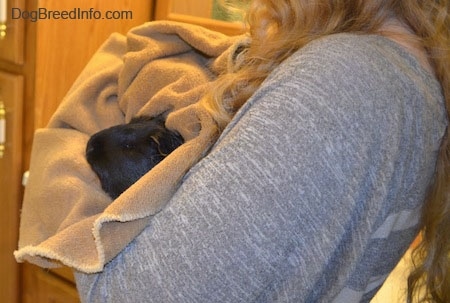
After the bath, wrap it in a clean, dry towel and keep it warm until it is fully dry.
Abigail is our guinea pig and she is about 4 years old. She is such a great pet to have as she doesn't bite. She loves being petted and purrs when you stroke her. She lives in a cage in our house and likes to get out in the good weather to munch on the grass.
Abigail the 4-year-old guinea pig
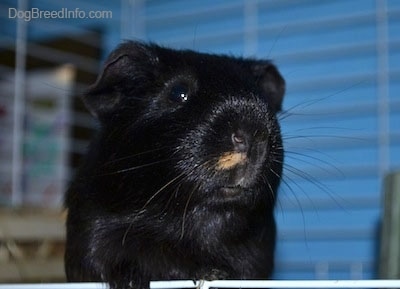
This is Bruce, named after Bruce Wayne aka Batman, in his "look at me I'm handsome" pose.
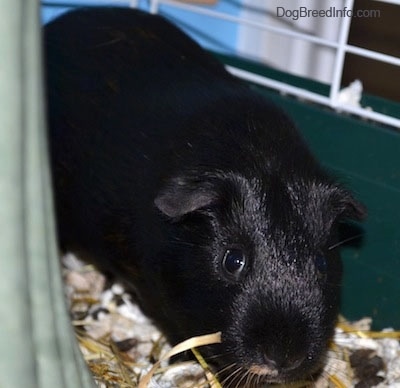
Bruce peeking around the corner
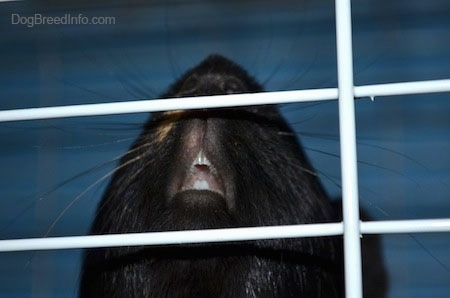
Bruce showing off his cute little teeth—Guinea pigs need to chew to keep their teeth filed down. Bruce likes to gnaw on alfalfa hay.
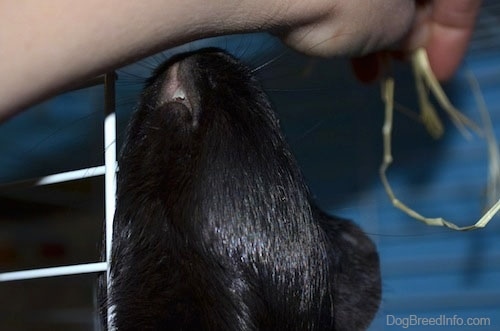
Bruce trying to see if I have any food for him in my hand
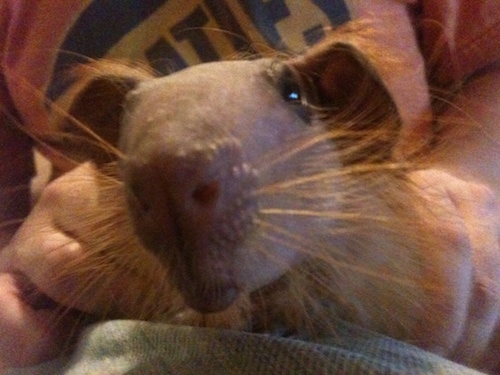
Lil' Scarlette the Hairless Baldwin Guinea Pig at 4 weeks old—"Lil' Scarlette is 4 weeks old in this photo and well on her way to becoming hairless. The baldwin guinea pig is very rare. They are born with some fur that starts falling out around their head moving to the rest of their body, leaving them completely bald by the time they are 6 to 9 weeks old."